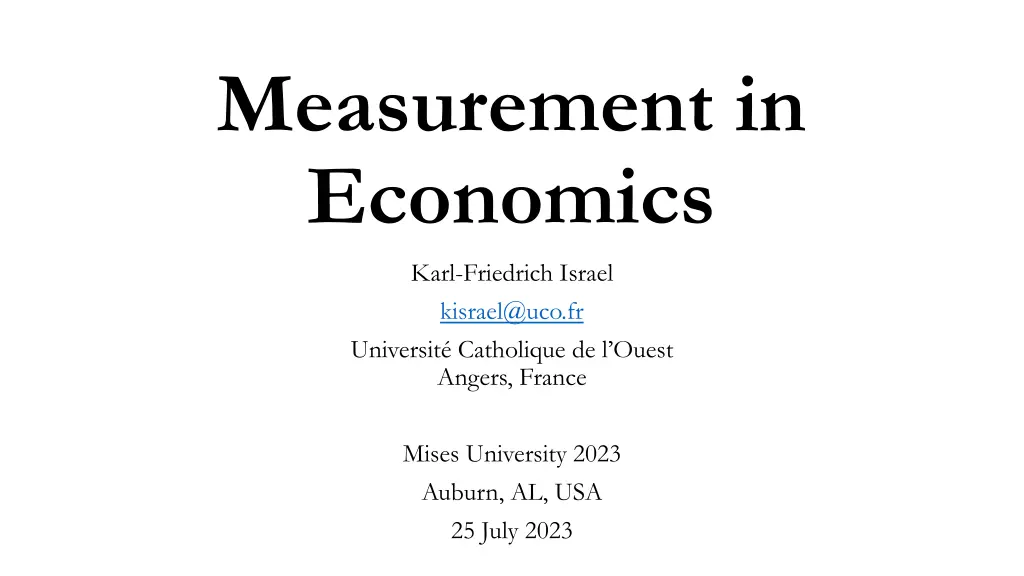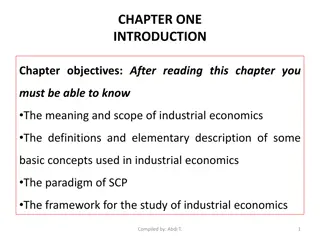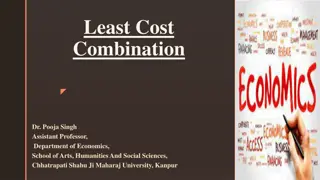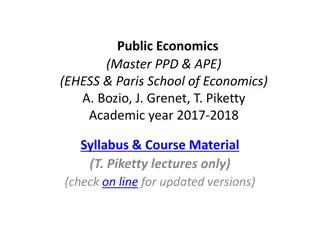
Modern Econometrics: Theory and Application
Explore the intersection of Keynesian economics and modern econometrics in the 20th century. Learn about the Nobel Prize-winning pioneers, Frisch and Tinbergen, who shaped the discipline. Discover how econometrics aims to turn pure economics into a science through theoretical-quantitative and empirical-quantitative approaches. Dive into the evolution of macroeconomic models and the importance of methodological development in economics.
Download Presentation

Please find below an Image/Link to download the presentation.
The content on the website is provided AS IS for your information and personal use only. It may not be sold, licensed, or shared on other websites without obtaining consent from the author. If you encounter any issues during the download, it is possible that the publisher has removed the file from their server.
You are allowed to download the files provided on this website for personal or commercial use, subject to the condition that they are used lawfully. All files are the property of their respective owners.
The content on the website is provided AS IS for your information and personal use only. It may not be sold, licensed, or shared on other websites without obtaining consent from the author.
E N D
Presentation Transcript
Measurement in Economics Karl-Friedrich Israel kisrael@uco.fr Universit Catholique de l Ouest Angers, France Mises University 2023 Auburn, AL, USA 25 July 2023
Content 1. Introduction 2. The Program of Modern Econometrics 3. Utility and Welfare Economics 4. Econometrics as a Set of Descriptive Tools Reference: K.-F. Israel, Pawel Ciompa and the meaning of econometrics: a comparison of two concepts, The European Journal of the History of Economic Thought, (2023, forthcoming)
1. Introduction Two main developments in economics in the 20th century: In theory: Keynesian economics In methodology: Modern econometrics Most dominant branch of economics after World War II is found at the intersection of both developments Large-scale Keynesian macroeconomic models The methodological development has arguably been more important for the discipline
2. The Program of Modern Econometrics Nobel Memorial Prize in Economics (1969) Ragnar Frisch (1895-1973) Jan Tinbergen (1903-1994)
2. The Program of Modern Econometrics Intermediate between mathematics, statistics, and economics, we find a new discipline which for lack of a better name may be called econometrics. Econometrics has as its aim ... to turn pure economics, as far as possible, into a science in the strict sense of the word. R. Frisch (1926): Sur un probl me d conomie pure. Norsk Matematisk Forenings Skrifter Series 1 (16)
2. The Program of Modern Econometrics There are two aspects to modern econometrics: Theoretical-quantitative: reformulating economic theory in quantitative- mathematical terms Empirical-quantitative: empirically testing theoretical-quantitative propositions Unlike the attempts around 1838 (by Cournot) and 1870 (by Walras, Jevons and Menger) which did not succeed, the third wave of quantification was successful. Tinbergen (1973)
2. The Program of Modern Econometrics The econometric study that we present is an attempt to realize Jevon s dream [the author refers to the paragraph Numerical Determination of the Laws of Utility in the fourth edition of Jevons (1911)]: measure the variations of the marginal utility of economic goods. Frisch (1926) since the break-through of econometrics this is not a dream anymore but a reality Frisch (1970)
2. The Program of Modern Econometrics How did the dream become true? Mathematical axiomatization of economic theory (e.g.: determination, additivity, and transitivity of preferences) Utility as a well-defined mapping from multidimensional bundles of goods to a cardinal scale of measurement How to determine the mapping? - With choice questions (exp riences par interrogation) How to determine cardinal utility measurements from interview data? - With an appeal to everyday experience The scientific basis is very thin, but the implications, if the project were to succeed, are obvious: assessment and maximization of total welfare
3. Utility and Welfare Economics Utility theory analyzes the laws of value and choice of individuals Welfare theory analyzes the relationships between the values of many individuals, with the objective of drawing scientific conclusions on the desirability of various alternatives Assessing the welfare implications of Taxes Subsidies Price controls Monopoly Partial and complete economic planning
3. Utility and Welfare Economics Reservation prices of potential sellers: Reservation prices of potential buyers: Joe: Jeff: David: Mark: Shawn: $10 Mardy: Felicia: Pat: Suzy: Kristy: $2 $4 $6 $8 12 10 9 8 6
3. Utility and Welfare Economics Price in $ Reservation prices of potential sellers: 12 10 Joe: Jeff: David: Mark: Shawn: $10 $2 $4 $6 $8 8 6 4 Shawn David Mark 2 Jeff Joe 0 Quantity 5 2 3 4 1
3. Utility and Welfare Economics Price in $ Reservation prices of potential sellers: 12 Supply 10 Joe: Jeff: David: Mark: Shawn: $10 $2 $4 $6 $8 8 6 4 2 0 Quantity 5 2 3 4 1
3. Utility and Welfare Economics Price in $ Reservation prices of potential buyers: 12 Mardy Supply 10 Felicia Mardy: Felicia: Pat: Suzy: Kristy: 12 10 9 8 6 8 Pat Suzy 6 Kristy 4 2 0 Quantity 5 2 3 4 1
3. Utility and Welfare Economics Price in $ Equilibrium: 12 Supply 10 Price: $8 Quantity: 4 8 6 Demand 4 2 0 Quantity 5 2 3 4 1
3. Utility and Welfare Economics Price in $ Equilibrium: Mardy ($4) Felicia ($2) 12 Supply 10 Price: $8 Quantity: 4 Consumer surplus: $4 + $2 + $1 + $0 = $7 Pat ($1) Suzy ($0) Kristy ($0) 8 6 Demand 4 2 0 Quantity 5 2 3 4 1
3. Utility and Welfare Economics Price in $ Equilibrium: 12 Supply 10 Price: $8 Quantity: 4 Consumer surplus: $4 + $2 + $1 + $0 = $7 Producer Surplus: $6 + $4 + $2 + $0 = $12 Shawn ($0) 8 Mark ($0) 6 Demand David ($2) 4 Jeff ($4) 2 Joe ($6) 0 Quantity 5 2 3 4 1
3. Utility and Welfare Economics Price in $ Equilibrium: 12 Supply 10 Price: $8 Quantity: 4 Consumer surplus: $4 + $2 + $1 + $0 = $7 Producer Surplus: $6 + $4 + $2 + $0 = $12 Total welfare: $7 + $12 = $19 8 6 Demand 4 2 0 Quantity 5 2 3 4 1
3. Utility and Welfare Economics Price in $ Price floor of $11 Welfare loss from price controls: Price: $11 Quantity: 1 12 Supply 10 8 6 Demand 4 2 0 Quantity 5 2 3 4 1
3. Utility and Welfare Economics Price in $ Price floor of $11 Welfare loss from price controls: Price: $11 Quantity: 1 Consumer surplus: $1 Producer surplus: $9 Total welfare: $10 12 Supply 10 8 6 Demand 4 Welfare loss: $9 2 0 Quantity 5 2 3 4 1
3. Utility and Welfare Economics Price in $ Price floor of $11 Welfare loss from price controls: Price: $11 Quantity: 1 Consumer surplus: $1 Producer surplus: $9 Total welfare: $10 12 Supply 10 8 6 Demand 4 Welfare loss: $9 2 0 Quantity 5 2 3 4 1
3. Utility and Welfare Economics Price in $ Price floor of $11 Welfare loss from price controls: Price: $11 Quantity: 1 12 Supply 10 8 That s ridiculous!!! 6 Demand 4 2 Muahaha!!! 0 Quantity 5 2 3 4 1
3. Utility and Welfare Economics Price in $ Price floor of $11 Welfare loss from price controls: Price: $11 Quantity: 1 Consumer surplus: $1 Producer surplus: $1 Total welfare: $2 12 Supply 10 8 6 Demand 4 Welfare loss: $17 (Additional loss of $8) 2 0 Quantity 5 2 3 4 1
3. Utility and Welfare Economics Price in $ Price floor of $11 D. Schmidtz (2015): Are Price Controls Fair?, Supreme Court Economic Review 23(1): 221-233 The standard analysis only gives the lower bound of the welfare loss (the best-case scenario) 12 Supply 10 8 6 Demand 4 2 0 Quantity 5 2 3 4 1
3. Utility and Welfare Economics Price Welfare loss of an excise tax The tax can be understood as an increase in costs Supply Demand Quantity
3. Utility and Welfare Economics Price Welfare loss of an excise tax The tax can be understood as an increase in costs When demand is price-elastic, the reduction in the quantity exchanged is big Welfare loss is big Supply Demand Quantity
3. Utility and Welfare Economics Price Welfare loss of an excise tax The tax can be understood as an increase in costs Supply Demand Quantity
3. Utility and Welfare Economics Price Welfare loss of an excise tax The tax can be understood as an increase in costs When demand is price-inelastic, the reduction in the quantity exchanged is small Welfare loss is small Supply Demand Standard conclusion: tax markets with price-inelastic demand (and supply) Quantity
3. Utility and Welfare Economics Price T. Fegley, K. Hansen, and K-F. Israel (2023): Clarifying the analysis of deadweight loss from taxation. Cahiers de recherche de l AFREA, Document-002 Supply Demand Quantity
3. Utility and Welfare Economics Price Overall spending increases T. Fegley, K. Hansen, and K-F. Israel (2023): Clarifying the analysis of deadweight loss from taxation. Cahiers de recherche de l AFREA, Document-002 Some other market: Additional loss Standard analysis underestimates the welfare loss Supply Demand Quantity
3. Utility and Welfare Economics Both criticisms (Schmidtz; Fegley et al.) can be considered internal criticisms, but they point at an important problem: the fallacious assumption of constancy (ceteris paribus) More fundamental criticism in Rothbard (1956): Toward a Reconstruction of Utility and Welfare Economics based on two principles: 1. Unanimity rule (Pareto principle) 2. Demonstrated preferences (contingent on time and circumstances) Rothbard draws two main conclusions: 1. the free market always increases social utility 2. no act of government can ever increase social utility
3. Utility and Welfare Economics We cannot measure utility quantitatively; it is not cardinal; it cannot be added or interpersonally compared there is no such thing as a toral utility to be maximized ( all utilities are marginal ) Even if you could (at least indirectly) measure utility from demonstrated preferences in a certain situation, it is unjustified to hold these measures constant to be applied in other situations The lack of constancy jeopardizes not only the application of standard welfare economics to the real world, but also undermines an important part of the econometric program in general
4. Econometrics as a Set of Descriptive Tools Description vs. induction The basic idea of inductive econometrics: Measurable causes Measurable effects ?1 Model ? (some functional relationship) ?2
4. Econometrics as a Set of Descriptive Tools The basic idea of inductive econometrics: Measurable causes Measurable effects ?1 Model ? ?? (some functional relationship) ?2
4. Econometrics as a Set of Descriptive Tools The basic idea of inductive econometrics: Measurable causes Measurable effects ?1 Model ? ?? (some functional relationship) Maybe it is non- linear? ?2
4. Econometrics as a Set of Descriptive Tools The process of hypothesis testing and revising presupposes a constant underlying structure between causes and effects Mises: no constants in economics Hoppe (1983): the constancy principle (equal causes lead to equal effects & different effects imply unequal causes) does not hold in economics Why? ?1 ? Human beings are capable of learning ?2
4. Econometrics as a Set of Descriptive Tools The inductive part of modern econometrics is problematic The descriptive part is not Pawel Ciompa (1910): econometrics (economographics) as a descriptive economics econometrics is then just the theory of accounting. Empirical-quantitative-statistical methods are tools to describe economic phenomena and developments Their explanations come from economic theory






















